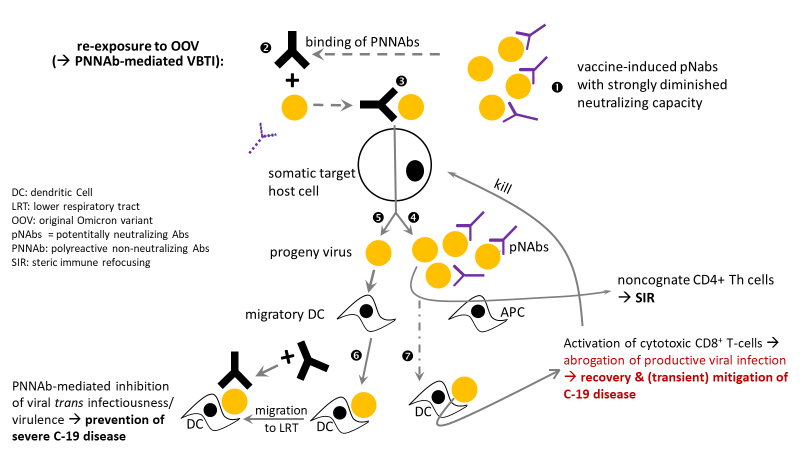Content Sections
It is with great pleasure that we offer you this article from Dr Geert Vanden Bossche.
Dr Vanden Bossche has been among the most outspoken vaccinologists during the last 3 years, warning of the risks of mass vaccination during a pandemic and the consequent impacts of evolutionary pressure generated by the vaccines, and the immune consequences, especially on the youngest members of society.
This particular article is incredibly timely given the escalating rates of hospitalisations of children with lung infections that are being reported in a number of highly vaccinated countries. Many of us have, or know of, young loved ones in this predicament. In his article, Geert explains the likely mechanism of how and why this is happening, pointing to the role of covid-19 mass vaccination programs, the ongoing circulation of SARS-CoV-2 Omicron descendants, and interference with the normal development of trained innate immunity in children.
Those who are less familiar with the science may need to read some of Geert's sentences more than once, but—as is always the case with Geert's writings—the insights are rich, rewarding and potentially life changing.
Please share widely.
Over to Geert...
As a vaccinologist, immunologist, innovator, entrepreneur and visionary, Dr Vanden Bossche has been invited to speak at multiple international congresses. His work and supportive advice are driven by a strong motivation to translate scientific breakthroughs into competitive solutions to emerging challenges in public and global health.
Besides his passion for the Life Sciences, Dr Vanden Bossche has also a strong passion to seek and maintain the truth, based on the best and most relevant available evidence. Back in 2015, he scrutinized and questioned the safety of the Ebola vaccine that was used in ring vaccination trials conducted by the WHO in Guinea. His critical scientific analysis and report on WHO data was published in The Lancet in 2015 and was sent to all international health and regulatory authorities involved with the Ebola vaccination program.
Dr Vanden Bossche has been one of the most prominent critics of mass vaccination during a pandemic. He gained fame around the world in March 2021 when he warned the WHO and the public over the consequences of launching a globally coordinated, mass vaccination programs during the Covid-19 pandemic. His countless scientific contributions, both orally and in writing, can be found on the website of Voice for Science and Solidarity, the organization he founded in 2021.
By Geert Vanden Bossche PhD
Several countries have been reporting a spike in cases of white lung pneumonia (e.g., China, the Netherlands, the UK, the USA, Denmark). While the vaccination status of school-age children contracting white lung pneumonia (WLP) is rarely reported, it is highly improbable that these cases are linked to COVID- 19 (C-19) vaccination. This is because vaccination rates in this age group remain very low. It is also highly unlikely that the lifting of previous restrictions on social interactions contributed to the spike in cases, as variants circulating since the advent of Omicron are highly infectious and often transmitted asymptomatically. The fact that WLP is not only reported in China, but in several other countries shows that previous confinement policies no longer have any impact on the landscape of currently circulating SARS- CoV-2 (SC-2) variants.
The reason why WLP predominantly (but not exclusively) affects children aged 5 to 12 is that, at this stage, they have not yet transitioned from natural/innate antibody(Ab)-mediated protection against glycosylated components1 to trained, cell-mediated innate immunity2. This plays a crucial role in the putative pathogenesis outlined below.
WLP shares similarities with MIS-C (multisystemic inflammatory syndrome in children), observed in children of the same age group (5-12 years), often following a previous mild infection. Similar to MIS-C, WLP is a post-infectious inflammatory condition resulting from heightened viral infectivity.
In the case of MIS-C, this enhanced infectivity is due to infection-enhancing anti-S(pike) antibodies (Abs) generated upon re-exposure after a mild SC-2 infection. As some children are exposed to new, more infectious SC-2 variants shortly after experiencing a mild infection, the previously infection-primed anti-S Abs' neutralizing capacity proves insufficient to neutralize the new variant. Due to their significantly diminished neutralizing capacity, these Abs are believed to foster the formation of multimeric virus-Ab complexes while outcompeting the child's innate, low-affinity IgM Abs. While enhanced viral infectiousness, combined with sidelined innate Abs, occasionally led to systemic inflammatory disease (i.e., 'multi-systemic' inflammation), severe C-19 disease was averted due to the infection-enhancing non-neutralizing Abs (NNAbs), which mitigate viral virulence.
The enhanced infectivity of SC-2 likely underlying WLP is attributed to the high intrinsic infectiousness of circulating Omicron descendants, while neutralizing Abs (NAbs) produced in response to a mild infection outcompete the child’s innate, low-affinity IgM Abs. The combined impact of increased intrinsic infectiousness and the sidelining of innate Abs occurs at a stage when the child’s natural killer (NK) cells are still predominantly 'pathogen-inexperienced.' It is reasonable to assume that this combined impact renders some previously infected children susceptible to breakthrough infections (BTIs), subsequently promoting the formation of multimeric complexes between the progeny virus and poorly neutralizing, previously infection-primed Abs. As explained earlier, these multimeric virus-Ab complexes stimulate the production of NNAbs, thereby protecting unvaccinated children from severe C-19 disease.
I previously described how dendritic cells (DCs) patrolling the upper respiratory tract (URT) may migrate to the lung after encountering highly infectious SC-2 in the URT. Highly infectious variants provoke an overall immune environment that is unfavourable to antigen uptake by DCs, thereby hindering the maturation of DCs and their migration to the local draining lymph nodes. Instead, highly infectious SC-2 virions adsorb to the surface of these DCs when causing BTI in the URT (see fig. 1 below). Although NNAbs3 elicited upon immune system stimulation by complexes of progeny virus and Abs with strongly diminished neutralizing capacity prevent the transfer of these highly infectious SC-2 variants to susceptible lung cells, massive migration of virus-tethered DCs to the lung likely triggers extensive inflammation, thereby promoting colonization of the lungs with commonly circulating pneumotropic pathogens (i.e. pathogens like SC-2 that have an affinity for or are directed towards lung tissues) (see below).
The pathogenesis explained above suggests that enhanced microbial infection is not the cause, but rather secondary to pulmonary (lung) inflammation. I therefore prefer to refer to this condition as white lung syndrome (WLS) rather than WLP. All individuals whose innate immune response towards glycosylated viruses has been sidelined and possess Abs with strongly diminished neutralizing capacity could, therefore, become susceptible to WLP. I therefore tend to believe that, besides children, this disease could also affect C-19 vaccinees, particularly those who have not yet developed sufficiently strong CTL (cytotoxic T lymphocyte) activity to eliminate highly infectious progeny virus before it massively adsorbs onto URT-resident DCs.
As the sidelining of cell-based innate immunity would impact protection against glycosylated microorganisms, it is not surprising that enhanced lung inflammation is associated with colonization of the lower respiratory tract by Mycoplasma pneumoniae, RSV, Influenza or even Streptococcus pneumoniae. Since there are no human vaccines for these airborne pathogens (e.g., Mycoplasma pneumoniae and RSV in children), or as children are not vaccinated against Influenza, the immune defense against these pathogens largely depends on short-lived pre-existing Abs (only in case of previous infection) and/or innate immunity.
Based on the putative mechanism of pathogenesis, I postulate that, similar to MIS-C, the wave of inflammatory lung disease will be short-lived. As the pandemic evolves and more infectious EG.5 or BA2.86 descendants start dominating the scene, I anticipate a rapid fall in the number and severity of WLS cases. The reason is that when viral infectiousness increases, more children will become re-exposed to a circulating variant at an earlier stage in life, i.e., at a timepoint where their innate Ab titers are high enough to cope with the highly infectious circulating variants, thus decreasing the risk of symptomatic infection. More children will , therefore, develop asymptomatic infections and be unlikely to see their innate Ab capacity dramatically reduced by infection-primed S-specific NAbs. But also in vaccinees, the risk of WLP will decrease as more vaccinees are now progressing to develop enhanced CTL activity (due to an increased uptake of large virus-Ab complexes), thereby decreasing the viral load adsorbed on migratory DCs (see fig. below).
The bottom-line is that in all cases, inflammatory organ disease in unvaccinated children is caused by enhanced viral infectivity, either due to Ab-dependent enhancement of infection or enhanced intrinsic infectiousness of circulating variants. In both scenarios, the higher infection rate in the population (including households!) comes with an added likelihood for children to become re-infected shortly after their previous asymptomatic infection, thereby sidelining the innate immune response against airborne glycosylated viruses.
It is crucial to understand that both the enhancement of viral infection and enhanced intrinsic viral infectiousness directly result from collective immune pressure placed on viral infectivity as a consequence of mass vaccination. This population-level immune pressure has driven natural selection and the (co-) circulation of more infectious immune escape variants.
Similar to MIS-C, WLS should resolve within a few days after timely and adequate immunosuppressive and anti-inflammatory treatment. Neither MIS-C nor WLS justifies C-19 vaccination for children, as C-19 vaccines, particularly mRNA vaccines, promote the sidelining of the child’s cell-based innate immune system. In the context of WLS, the argument that a large-scale rollout of updated C-19 vaccines would control viral infectivity is incorrect. This is because updated C-19 vaccines, at best, boost titers of subneutralizing Abs, the low affinity of which would only contribute to increasing the collective immune selection pressure on viral infectiousness and, consequently, promote the pathogenesis of WLS in children.

Fig.1: Pathogenesis of Ab-independent vaccine breakthrough infection (VBTI)BTI. High intrinsic infectiousness of co-circulating Omicron descendants precipitates infection of target host cells (1) and enhances the production rate of highly infectious progeny virus. The latter predominantly adsorbs onto tissue-resident DCs and thereby causes pre-existing PNNAbs to only bind in relatively low concentration to progeny virus tethered to migratory DCs (2). Diminished virulence-inhibiting capacity of pre-existing PNNAbs causes highly C-19 vaccinated populations to raise immune selection pressure on viral virulence while still protecting vaccinees from severe disease. Once binding of low-affinity IgG4 Abs to progeny virus results in the formation of large virus-Ab complexes, the concentration of progeny virus adsorbed to DCs will diminish and thereby reduce the risk of WLS. Instead, enhanced uptake of IgG4 Ab-virus complexes into patrolling APCs facilitates strong activation of cytotoxic T cells (CTLs) and thereby enables elimination of virus-infected host cells (3). However, deficient recall of T helper memory cells will entail a decline in PNNAb titers. As a result, PNNAb-mediated population-level immune selection pressure on viral virulence will gradually increase upon subsequent VBTIs caused by circulating, highly infectious variants. Dominant circulation of immune escape variants with an ever-increasing intrinsic infectiousness will ultimately cause the highly C-19 vaccinated population to raise the immune selection pressure on viral virulence beyond the threshold triggering selection of new, highly virulent variants that enable large-scale occurrence of PNNAb-dependent enhancement of severe disease (ADESD). Individuals in whom a significant portion of highly infectious progeny virions are adsorbed to DCs, rather than being complexed by IgG4 Abs to form aggregates that are subsequently taken up by APCs, are considered at risk of developing WLS. (source: Voice for Science and Solidarity).
1 Including viruses or small microorganisms containing glycosylated components in their envelope/ membrane
2 As children grow older, they progressively replace the ‘self’-sensing innate Ab capacity by a pool of pre-primed Natural Killer cells that can recognize pathogen-derived self-mimicking (i.e., ‘altered self’) motifs on virus-infected or otherwise pathologically altered host cells such as to kill those cells.
Top tips to support immune function - naturally
Build your immune resilience - as nature intended
Immune resilience - adapt, don't fight!
Inbuilt defences – our forgotten medicine
>>> If you’re not already signed up for the ANH International weekly newsletter, sign up for free now using the SUBSCRIBE button at the top of our website – or better still – become a Pathfinder member and join the ANH-Intl tribe to enjoy benefits unique to our members.
>> Feel free to republish - just follow our Alliance for Natural Health International Re-publishing Guidelines
>>> Return to ANH International homepage









Comments
your voice counts
30 December 2023 at 12:59 pm
Most types of pneumonia will show up on imaging scans as white patches in the lungs, indicating areas of inflammation. Therefore, the term ‘white lung’ is not a diagnosis and does not have any clinical meaning beyond its descriptive value. The patches showing up are areas with denser lung tissue, which can occur when the body fights infections with common causing bacteria like Mycoplasma pneumoniae. Various immune-related explanations may be attributed, depending on the proclivity of the author.
Your voice counts
We welcome your comments and are very interested in your point of view, but we ask that you keep them relevant to the article, that they be civil and without commercial links. All comments are moderated prior to being published. We reserve the right to edit or not publish comments that we consider abusive or offensive.
There is extra content here from a third party provider. You will be unable to see this content unless you agree to allow Content Cookies. Cookie Preferences